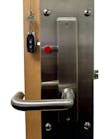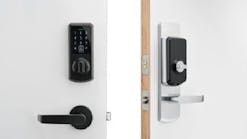"Aging in place" is commonly defined as "the ability to live in one’s home and community safely, independently, and comfortably, regardless of age, income, or ability level."
Individual senior citizens who want to age in place probably define this trend differently. They simply want to remain in the place where they are comfortable, where they’ve lived for a long time and plan on living a lot longer. Not to mention they want to stay in a house that may be largely paid off and thus, is very affordable. Ultimately, they want to stay home.
Many companies are dedicated to making aging in place a reality, with products and services that meet seniors’ changing needs and that ensure their homes are well-kept, comfortable and secure. Today’s home automation technology is at the forefront of this movement. An example of home automation products that can bring a greater level of safety to aging in place environments are motion control detectors. These devices can be placed at the bottom of stairwells, in bedrooms, and in medicine cabinets; red flags related to potential health issues are raised when motion is not detected for a length of time. Motion detectors can also be put on refrigerators to make sure that older people are eating on a regular basis.
One home automation product that's playing a central role in facilitating the aging in place trend is the electronic or “smart lock.” Multi-functional, easy-to-use and extremely secure, the latest generation of electronic door locks is providing live-at-home seniors with the highest level of security, and their adult children with greater peace of mind. These new smart locks automatically lock doors and keep homes secure through the use of personal numeric codes as opposed to keys that can easily be lost or stolen.
They can also provide senior residents and their adult children with even greater access control, when the locks are a part of a home automation system such as those that use Zigbee or Z-Wave technology. With these smart locks, unwanted guests are kept out, while access can be granted to loved ones, caregivers, and even first responders in emergency situations. And this access is allowed without anyone ever having to physically use a key.
With today’s smart locks, information is both power and peace of mind, especially in aging-in-place scenarios. With traditional locks, there is no information provided. With early iterations of electronic locks, you could learn whether a door is locked or unlocked, but not necessarily by whom.
But with the advanced capability of today’s electronic smart locks, there is an opportunity to know not only who unlocked a door but also who locked it, or re-locked it -- and when. In addition, caregivers can potentially collect even more information about what is going on in the home.
An electronic smart lock can play three primary roles in accommodating aging in place:
- Smart locks allow the adult children to monitor the elderly person’s activity. The lock itself can be viewed as a kind of “sensor,” providing information about what is going on inside a home – such as who has been granted access and when. Family members and caregivers have to play a central role in making this work. Locks can be programmed to send out emails and texts regarding who is accessing the home. Caregivers need to configure these communications around the specific information they want to get. They also need to monitor these communications to ensure security and safety is maintained. For example, they need to monitor who is locking or unlocking a door. They need to be aware of any exceptions have been allowed (such as providing a short-term access code to a service provider). If a lock has not been opened for a day or two, they need to recognize this as a red flag. And if the lock is determined to be unlocked, it can be locked remotely by the adult child.
- Smart locks can provide customized access. Individual access codes can be provided to any authorized people who might need access to the home and its residents. These can be service technicians, such as plumbers or electricians, or they can be healthcare professionals authorized to enter in the event of a medical emergency.
- Smart locks can simplify caregiver management, and make it safer. Because access codes can be changed and multiple codes can be used, keys never have to be provided to caretakers.
It’s a reality that caretakers such as housekeepers change over time; with smart locks, when caretakers change, codes can change, so there is never a worry about where those stray keys have gone. Access availability can also be scheduled for a caregiver, designating specific times of day when their code will work.
Are the “Aging in Place” benefits of Smart Locks hitting home? The answer to this question is “not yet.” Home automation system providers and smart lock manufacturers are still in the process of understanding and communicating the multitude of benefits that their products can bring to homeowners. Many potential customers may recognize the convenience that is intrinsic to home automation systems, and the enhanced security provided by smart locks. But they are not yet making the leap to understanding the role that home automation and smart locks can play in specific applications such as aging in place.
It’s really up to security dealers and installers to sell the value to consumers. They must directly communicate the benefits that current smart locks can bring to this aging in place scenario – with capabilities like monitoring senior activity, providing remote access, and simplifying caregiver management. The technology to facilitate aging in place and make it more secure exists today. It’s in the smart lock. Locksmiths just need to spread the word about the smart lock’s “aging in place” benefits in order to lock up sales in a market that may be growing older, but is also growing bigger.
Keith Brandon is the Divisional Vice President – Residential Access Solutions (RAS) Sales and Marketing for Kwikset.
Senior Living Modifications
According to research by the American Association of Retired Persons (AARP), www.aarp.org:
- Nearly 90 percent of seniors want to stay in their own homes as they age, often referred to as “aging in place.”
- Even if they begin to need day-to-day assistance or ongoing health care during retirement, most (82 percent) would prefer to stay in their homes. Only a few express a preference for moving to a facility where care is provided (9 percent) or for moving to a relative’s home (4 percent).
- Living under one’s own rules is a key reason for staying in one’s own home, with 42 percent of seniors choosing it as one of their top three considerations.
AARP identified housing features that seniors find are especially important in the later years as they begin to experience reduced eyesight, poorer balance, reduced flexibility, etc.:
- Safety features such as non-slip floor surfaces (80 percent)
- Bathroom aides such as grab bars (79 percent)
- A personal alert system that allows people to call for help in emergencies (79 percent)
- Entrance without steps (77 percent)
- Wider doorways (65 percent)
- Lever-handled doorknobs (54 percent)
- Higher electrical outlets (46 percent)
- Lower electrical switches (38 percent)
Most of these features do not currently exist in most seniors’ homes.
Of seniors who have made modifications to their homes:
70 percent said they did so for safety reasons
65 percent wanted to make the home easier to use by all family members
60 percent wanted to increase their ability to live independently
55 percent wanted to provide flexibility to adapt to the changing needs of family members






